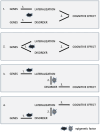The Balance in the Head: How Developmental Factors Explain Relationships Between Brain Asymmetries and Mental Diseases
- PMID: 40002502
- PMCID: PMC11852682
- DOI: 10.3390/brainsci15020169
The Balance in the Head: How Developmental Factors Explain Relationships Between Brain Asymmetries and Mental Diseases
Abstract
Cerebral lateralisation is a core organising principle of the brain that is characterised by a complex pattern of hemispheric specialisations and interhemispheric interactions. In various mental disorders, functional and/or structural hemispheric asymmetries are changed compared to healthy controls, and these alterations may contribute to the primary symptoms and cognitive impairments of a specific disorder. Since multiple genetic and epigenetic factors influence both the pathogenesis of mental illness and the development of brain asymmetries, it is likely that the neural developmental pathways overlap or are even causally intertwined, although the timing, magnitude, and direction of interactions may vary depending on the specific disorder. However, the underlying developmental steps and neuronal mechanisms are still unclear. In this review article, we briefly summarise what we know about structural, functional, and developmental relationships and outline hypothetical connections, which could be investigated in appropriate animal models. Altered cerebral asymmetries may causally contribute to the development of the structural and/or functional features of a disorder, as neural mechanisms that trigger neuropathogenesis are embedded in the asymmetrical organisation of the developing brain. Therefore, the occurrence and severity of impairments in neural processing and cognition probably cannot be understood independently of the development of the lateralised organisation of intra- and interhemispheric neuronal networks. Conversely, impaired cellular processes can also hinder favourable asymmetry development and lead to cognitive deficits in particular.
Keywords: cognitive impairment; gene environment; lateralisation; ontogeny; stress; translational/preclinical research.
Conflict of interest statement
The authors declare no conflicts of interest.
Figures


Similar articles
-
Hemispheric asymmetries in mental disorders: evidence from rodent studies.J Neural Transm (Vienna). 2023 Sep;130(9):1153-1165. doi: 10.1007/s00702-023-02610-z. Epub 2023 Feb 26. J Neural Transm (Vienna). 2023. PMID: 36842091 Free PMC article. Review.
-
Atypical lateralization in neurodevelopmental and psychiatric disorders: What is the role of stress?Cortex. 2020 Apr;125:215-232. doi: 10.1016/j.cortex.2019.12.019. Epub 2020 Jan 16. Cortex. 2020. PMID: 32035318 Review.
-
Intrahemispheric white matter asymmetries: the missing link between brain structure and functional lateralization?Rev Neurosci. 2016 Jul 1;27(5):465-80. doi: 10.1515/revneuro-2015-0052. Rev Neurosci. 2016. PMID: 26812865 Review.
-
The effects of multi-task learning and time-varying hemispheric asymmetry on lateralisation in a neural network model.Laterality. 2004 Apr;9(2):113-31. doi: 10.1080/13576500244000300. Laterality. 2004. PMID: 15382713
-
Asymmetry in the Central Nervous System: A Clinical Neuroscience Perspective.Front Syst Neurosci. 2021 Dec 14;15:733898. doi: 10.3389/fnsys.2021.733898. eCollection 2021. Front Syst Neurosci. 2021. PMID: 34970125 Free PMC article. Review.
References
-
- Ocklenburg S., Güntürkün O. The Lateralized Brain: The Neuroscience and Evolution of Hemispheric Asymmetries. 2nd ed. Academic Press; New York, NY, USA: 2024.
Publication types
Grants and funding
LinkOut - more resources
Full Text Sources

